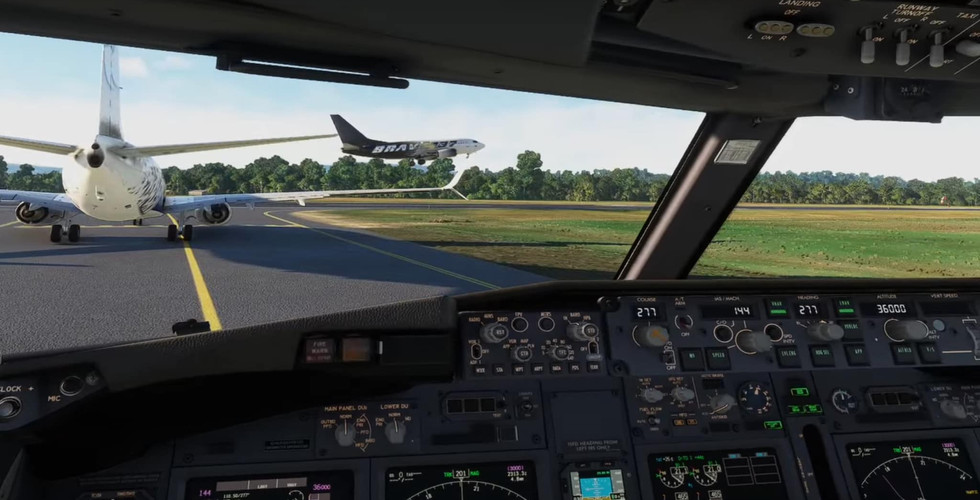UNDERSTANDING THE SCIENCE BEHIND THE SIM IMMERSION
- Captain Russell

- Aug 26
- 4 min read
During a recent group fly-in, my wife entered the room where my flight simulation set-up is located. Little did she know, I was fully "plugged-in" with full VATSIM ATC (Center, Approach, Tower and Ground) in the transition with about fifteen other aircraft either entering the approach with me, in the pattern already or departing on the other side of which I was being made aware by controllers as they climbed out of the area and onto their cruise transition.
I over explain that to share that as she was apparently talking to me, I was so deeply

immersed in the sim experience, I did not hear her (I do wear headphones and a mic), I did not see her, I did not acknowledge she had entered the room and it wasn't until she touched me on the shoulder, I was able to pull my gaze from outside of the sim pit and up toward the reflection of her in the front screen and then of course, when I turned to face her.
First, I felt awful that I didn't even see her. That showed me how involved I was in this situation - maybe not in a healthy manner. But then, this made me very curious as to how we, as humans, can buy into such a deep level of immersion. Granted, it was a pretty specific and hectic time in my simulated flight, but still - I was all in!
What I found was intriguing and I thought I would share. A warning for those who are going to read this - you are not going to get a light hearted description...I am about to go deep! According to several different sources (I am about to smush them all together), Immersion works for humans because the brain can actively simulate and engage with fictional environments, narratives, and sensory experiences, often by activating neural networks that mirror real-world perception and memory. This ability allows for the suspension of reality when engaging in video games, movies, or books by creating vivid mental models and emotional reactions as if the events were actually happening.
Scientific studies show that immersive experiences stimulate multiple regions of the brain, including those responsible for sensory-motor perception, emotion, and memory formation. For example, interacting with virtual objects or fictional scenarios can trigger neural activity similar to real-life engagement, leading to improved retention, emotional involvement, and spatial reasoning.
Suspension of Disbelief
Humans suspend disbelief during immersive experiences because the brain prioritizes internally simulated narratives, enabling deep focus and emotional investment in fictional stories. Engagement with immersive worlds (whether digital or textual) recruits attentional and executive processing networks, dampening outside distractions and reinforcing the perceived reality of the medium.

Embodied Cognition and Context
The concept of embodied cognition helps explain how immersion links physical interactions and sensory information (like motion in video games or visual descriptions in books) to language and memory. This mapping of fiction onto lived experiences makes stories and virtual worlds feel both realistic and deeply relatable, enhancing overall immersion.
Narrative and Emotional Engagement
Immersive storytelling, whether through film, games, or literature, is designed to create strong emotional responses and narrative identification. The mind’s ability to imagine, empathize, and engage with fictional characters or settings is rooted in evolutionary mechanisms for social learning and imagination.
Basically, the power of immersion, whether through media, games, or books, is grounded in the brain’s capacity to simulate reality, form emotional connections, and prioritize rich sensory and narrative experiences—allowing for the temporary suspension of reality.

What I find most interesting about these studies is it has somewhat little to do with the power of the video game, television show, etc. nor does it have to do with the peripherals, VR goggles or the like - it all boils down to our own minds and the ability for the human brain to map or craft an alternative reality which seems real, but suspends reality but uses "real life experiences" such as flying, driving, walking, hunting to enhance the sense of realism. For example, during the group flight I discussed when opening this article. The power of my mind and the convergence of others who are simultaneously suspending reality for their worlds are all bought in on the simulation. At that moment, we all "believe" what is happening is real. Don't believe me? Then the next time you are on final approach, try to pull yourself out of the daze and ask yourself why your hands are a little sweaty and your back is tense - it's just a game, right? No one dies if you float the landing.

No one has to call the tower if there is a runway incursion or someone says something stupid on the frequency. But you know what does happen - say it with me - we all get upset. Upset because that person or people didn't buy in to the suspended reality which we all hold tight for two, three, four or more hours as we grab plastic handles, rubber buttons and focus on screens of various sizes which transport us into the flight decks of our favorite airplanes.






















We do get upset but remember, we all have to learn and 95% of those breaking our belief mechanisms do so unintentionally. Nice article.